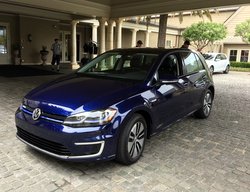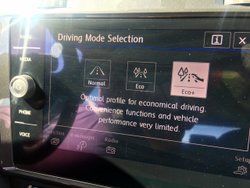More Range, Torque for our Favorite EV
The e-Golf is Volkswagen’s sole electric car in America—and we like it a lot—so when they go to great pains to make it better, we pay attention. As part of the well-regarded Golf family, an American mainstay since 1975, the e-Golf was introduced in 2015. Now, it gets significant upgrades that give it more market appeal.

The 2017 Volkswagen e-Golf drives and works just like its gas-fueled brethren. The downside was always its 83-mile range. So, the 2017 model gets a 50 percent boost—to 125 miles—thanks to its battery growing from 24.2 kW to 35.8 kWh. This puts it in competition with the current Nissan Leaf, BMW i3 (without range extender) and the new Hyundai Ioniq, and ahead of others, such as the Fiat 500e and Ford Focus Electric.
The on-board charger, available on the base model and standard on the upper levels, now has a 7.2 kW capacity, meaning a full charge from empty takes about six hours at Level 2 (240 volts). The EPA fuel economy numbers are 126 MPGe City, 111 mpg highway and 119 combined.
It’s not the 200+ miles of a Tesla or a Chevrolet Bolt, so that could remain a marketing challenge. However, 125 miles of range is probably all most people normally need. VW is counting on success based on the car’s other numerous merits.
Same Look Outside, But Underneath!
The new e-Golf sure looks the same, but there are some tweaks. Both ends are streamlined, with standard LED running lamps up front and fresh LED taillamps in the rear. The rear bumper boasts more elaborate detailing, with a chrome lower panel that, ironically, gives the appearance of twin exhaust outlets.

Inside, the center dash screen moves to a smooth, rimless design, and the quality of materials and layout of the panels remains high-class throughout.
VW boosted the car’s performance, with a larger 100 Kw motor (up from 85) that pulls the car from zero to 60 in a reasonable, but unspectacular, 9.6 seconds. Horsepower jumps from 115 to 134 and torque also rises from 199 to 214 pounds-feet.
A Three-County Test Drive
I had a chance to use up 90 of those range miles with a test drive through three counties to try out the new e. With a longtime writing colleague sharing the driving, we piloted an Atlantic Blue test car. This new shade, one of four new colors, moves from West to East Coast, replacing Pacific Blue in the color palette.

Our three-county trek started in from San Rafael, California—in Marin County. I drove the first leg of the trip, over the iconic Golden Gate Bridge, along city streets at the western edge of San Francisco (city and county), and down scenic Highway 1 along the ocean to Half Moon Bay (San Mateo County), where we enjoyed a delightful lunch with colleagues and VW folks.
Of course, the old car probably would have induced range anxiety on the way home! But 125 miles was plenty for the round trip, and we arrived back in San Rafael later that day with 54 miles still in the battery pack. Not a bit of nail biting.
Inside Details
The 2017 Volkswagen e-Golf coddles with soft, but supportive seats, and the controls have a solid, deliberate weight to them. Of course, having a 700-pound battery along the bottom of the car keeps the center of gravity low. With VW’s modular MQB platform, it doesn’t noticeably intrude into storage or passenger space, so it should be a comfortable cruiser for four.
The e-Golf provides a “B” setting on the one-speed transmission lever to add some regeneration when you lift off the accelerator. VW amusingly calls it “Recuperation.” The regen feels light compared to some systems, but you can see the car start producing electricity on the energy gauge when it’s set to B (and not go there when it’s set to D). You also can choose from three other levels, so it’s possible to fine-tune regeneration to suit your driving style.

As in many other cars, EV and not, you’ll find selectable driving modes—Eco, Eco+ and Normal. These differentiate by controlling accelerator function and climate control to conserve juice. We noticed that in ECO+ mode, the temperatures were not displayed in the climate control screen—presumably because it was disabled. My co-driver found that the car didn’t seem to want to move past 60 mph in Eco+ either.
Three display screens views show how you’re doing and what’s going on—typical of plugin vehicles. But the best feature of the new 2017 Volkswagen e-Golf is the comfortable, easy driving experience.
Pricing and release dates are not finalized, but these cars should be available later this year.
These upgrades will keep the 2017 Volkswagen e-Golf competitive in the short run, until the company debuts some of the promised new vehicles they’re showing off as concepts in their new I.D. EV sub-brand. Rising from its self-inflicted “diesel” crisis, the new VW aims to emerge as an EV champion.
Related Stories You Might Enjoy:
Road Test: 2014 Volkswagen e-Golf
Road Test: 2016 Nissan Leaf
Road Test: 2014 BMW i3
Road Test: 2016 Fiat 500e
Road Test: 2016 Ford Focus Electric
Personal: My Chevrolet Bolt One Month Along
Disclosure:
Clean Fleet Report is loaned free test vehicles from automakers to evaluate, typically for a week at a time. Our road tests are based on this one-week drive of a new vehicle. Because of this we don’t address issues such as long-term reliability or total cost of ownership. In addition we are often invited to manufacturer events highlighting new vehicles or technology. As part of these events we may be offered free transportation, lodging or meals. We do our best to present our unvarnished evaluations of vehicles and news irrespective of these inducements.
Our focus is on vehicles that offer the best fuel economy in their class. We also feature those that are among the top mpg vehicles in their class. In addition, we aim to offer reviews and news on advanced technology and the alternative fuel vehicle market. We welcome any feedback from vehicle owners and are dedicated to providing a forum for alternative viewpoints. Please let us know your views at publisher@cleanfleetreport.com.

7 thoughts on “First Drive: 2017 Volkswagen e-Golf”